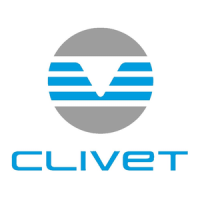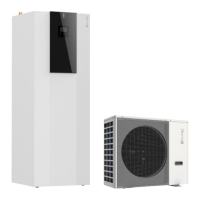Do you have a question about the CLIVET EVH Space 21 and is the answer not in the manual?
Details on the correct unit installation, use, and maintenance procedures.
General instructions for installation, operation, and safety compliance.
Guidance for users on manual keeping, unit identification, and operator training.
Information on the serial number label and its importance for unit identification.
Preliminary information and safety regulations for unit reception.
Procedures for checking the unit upon delivery for damage and correctness.
Instructions for handling the unit while it is still packaged.
Steps for safely removing the unit's packaging.
Preliminary information and safety regulations for unit positioning.
Guidelines for unit placement, including clearance and installation standards.
Recommendations for optimal placement of the thermostat for comfort and efficiency.
Preliminary information for water connection selection and installation.
Details on essential components for water connections like valves, gauges, and filters.
Steps for the operation sequence before and during water connection.
Instructions for proper condensate drain installation and siphon requirements.
Measures to prevent freezing of the unit and hydraulic connections.
General principles for proper execution and sizing of air connections.
Characteristics of ducts for treated air and features for grilles, outlets, and diffusers.
Preliminary information and safety regulations for electrical connections.
Details on fixing cables and avoiding contact with hot components.
Information on remote controls, mode changes, and signalization connections.
Initial checks and operational sequences before and during unit start-up.
Verification of cooling, hydraulic, electric circuits, and compressor resistors.
Monitoring voltages, pressures, and compliance with directives during start-up.
Description of operating modes (Manual, Auto, Eco, Clean, Ventilation) and set-point adjustment.
Control panel operations, parameter access, and definition of key parameters.
Overview of alarm codes, their meaning, reset procedures, and I/O status.
General principles, frequency, and scheduling of maintenance tasks.
Procedures for cleaning and maintaining water exchangers to ensure optimal thermal exchange.
Cleaning procedures for internal air coils and condensation trays for hygiene.
Maintenance of condensate discharge points to prevent obstructions and microbial growth.
Importance of clean air filters for thermal exchange, hygiene, and unit operation.
A checklist of recommended periodical maintenance checks and their frequencies.
General safety overview, dangerous area definition, and handling risks.
Risks associated with installation, location, and general environmental factors.
Risks related to electrical connections, moving parts, and coolant hazards.
Risks associated with hydraulic parts, coolant leaks, and gas explosions.
Procedures for safely disconnecting the unit before disposal.
Guidelines for dismantling and delivering the unit to authorized centers.
Information on the EC WEEE Directive for waste electric and electronic equipment.
Details on the correct unit installation, use, and maintenance procedures.
General instructions for installation, operation, and safety compliance.
Guidance for users on manual keeping, unit identification, and operator training.
Information on the serial number label and its importance for unit identification.
Preliminary information and safety regulations for unit reception.
Procedures for checking the unit upon delivery for damage and correctness.
Instructions for handling the unit while it is still packaged.
Steps for safely removing the unit's packaging.
Preliminary information and safety regulations for unit positioning.
Guidelines for unit placement, including clearance and installation standards.
Recommendations for optimal placement of the thermostat for comfort and efficiency.
Preliminary information for water connection selection and installation.
Details on essential components for water connections like valves, gauges, and filters.
Steps for the operation sequence before and during water connection.
Instructions for proper condensate drain installation and siphon requirements.
Measures to prevent freezing of the unit and hydraulic connections.
General principles for proper execution and sizing of air connections.
Characteristics of ducts for treated air and features for grilles, outlets, and diffusers.
Preliminary information and safety regulations for electrical connections.
Details on fixing cables and avoiding contact with hot components.
Information on remote controls, mode changes, and signalization connections.
Initial checks and operational sequences before and during unit start-up.
Verification of cooling, hydraulic, electric circuits, and compressor resistors.
Monitoring voltages, pressures, and compliance with directives during start-up.
Description of operating modes (Manual, Auto, Eco, Clean, Ventilation) and set-point adjustment.
Control panel operations, parameter access, and definition of key parameters.
Overview of alarm codes, their meaning, reset procedures, and I/O status.
General principles, frequency, and scheduling of maintenance tasks.
Procedures for cleaning and maintaining water exchangers to ensure optimal thermal exchange.
Cleaning procedures for internal air coils and condensation trays for hygiene.
Maintenance of condensate discharge points to prevent obstructions and microbial growth.
Importance of clean air filters for thermal exchange, hygiene, and unit operation.
A checklist of recommended periodical maintenance checks and their frequencies.
General safety overview, dangerous area definition, and handling risks.
Risks associated with installation, location, and general environmental factors.
Risks related to electrical connections, moving parts, and coolant hazards.
Risks associated with hydraulic parts, coolant leaks, and gas explosions.
Procedures for safely disconnecting the unit before disposal.
Guidelines for dismantling and delivering the unit to authorized centers.
Information on the EC WEEE Directive for waste electric and electronic equipment.











